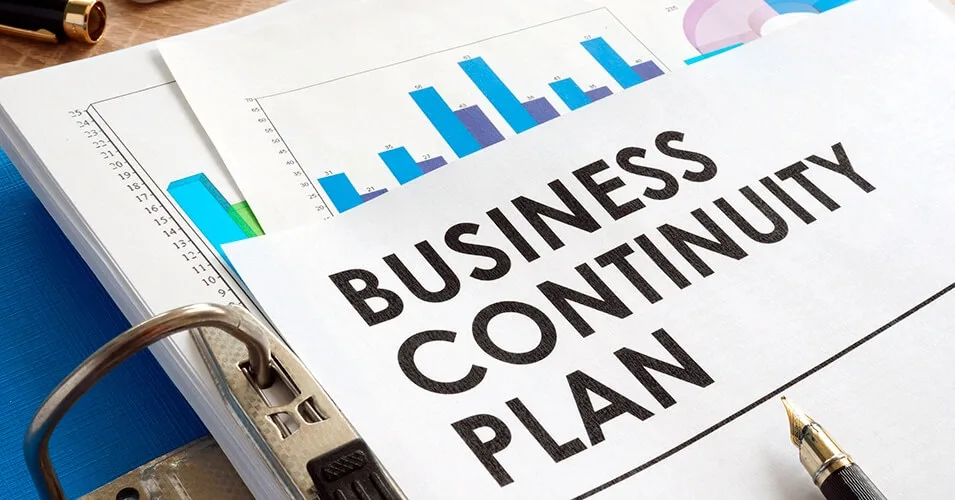
According to the World Economic Forum, the top global risks businesses face today include extreme weather, economic divergence, infectious diseases, and natural resource crises. Between the global threat landscape, ransomware attacks, supply chain shortages, and the ever-shifting business targets you have to hit as an organization, the cost of not having a business continuity plan is simply too high to overlook.
The true costs of not having a business continuity plan
It’s important to know the cost of not conducting business continuity planning – for your wallet and the future of your business.
Financial cost
If your business operations grind to a halt, it’s never convenient. Large enterprise businesses can expect downtime costing an average of $400,000 an hour. 35 percent of companies this size experience at least one outage per month. Financial loss can include lost productivity, revenue, data, and many other costs related to financials.
If ransomware causes a business interruption, that can also come with hefty financial damage. Data breaches from ransomware attacks have an average cost of $4.62 million for organizations worldwide.
The cost of a threat to your business continuity is likely to stay high because of:
- more attacks on supply chains
- a high number of data breaches
- cloud-based malware
- and an uptick in triple extortion (data encryption, theft, and DDoS attacks)
Reputation cost
Even if you are briefly out of commission, the cost a disruption can have on your reputation can be very damaging. The damage will be worse if the disruption happens at a crucial time for your organization and you lack adequate customer service to handle things.
If your customers or clients feel like they can’t rely on you, they may abandon your services and never return. Failing to effectively communicate your business continuity plan will make it worse. There is also a chance they will air their grievances on review sites and social media.
The cost to replace the business you lost can be make-or-break for your business. Downtime can also call into question how safe their data is with you, convincing them to leave.
Workforce cost
November 2021 saw a record number of people leaving their jobs. 4.5 million, according to the Bureau of Labor Statistics. IT teams may also be experiencing increased pressure and burnout due to these IT workforce shortages. Teams are scrambling to fill the gaps left by the shortages and may miss key vulnerabilities and suspicious network activity as a result.
When a vulnerability gets exposed or when a natural disaster hits, there’s also a larger potential for long-term outages and data loss. Businesses that don’t consider workforce shortages and employee burnout in their business continuity plan will be caught by surprise when an outage comes.
Regulatory cost
The cost of not having a business continuity plan when it comes to regulatory matters can be lofty. That is also true if you are unable to deliver on your contractual promises. Your customers may decide to pursue legal action for any unfulfilled commitments. Worse yet, there may be regulatory consequences for missing pieces of your plan.
Safety cost
Another potential cost may come from the worst-case scenario. If you do not relocate your workers during natural disasters, they may be subject to injuries, or even death. Not having a Plan B in place could very well be a life-or-death situation. Subjecting your staff to unsafe conditions can also cause reputation damage, worker churn, and lost revenue.
Cost of lost data
Data loss is more than a revenue drain. It can also mean you never recover vital information for future initiatives, necessary record-keeping, or a variety of other intended purposes. Failing to have recovery point objectives (RPO) and recovery time objectives (RTO) means you may lose an undetermined amount of data during a disaster that can never be retrieved. You also put your data at greater risk if your primary and backup data center sites are too close together, increasing your recovery costs.
Cost of not competing
These costs can also impact your ability to keep up with your competition. If your competitor offers a better, more thorough solution, all it takes is one outage for customers to lose faith and make a switch. Your competition may even use their preparedness against you when pitching to new customers.
Does the cost of not having a business continuity plan have you concerned?
You may be wondering what you can do to mitigate these myriad, intersecting costs of not having a business continuity plan. Read our strategic guide to disaster recovery and DRaaS for more information to help evaluate your business continuity and disaster recovery plan today.

